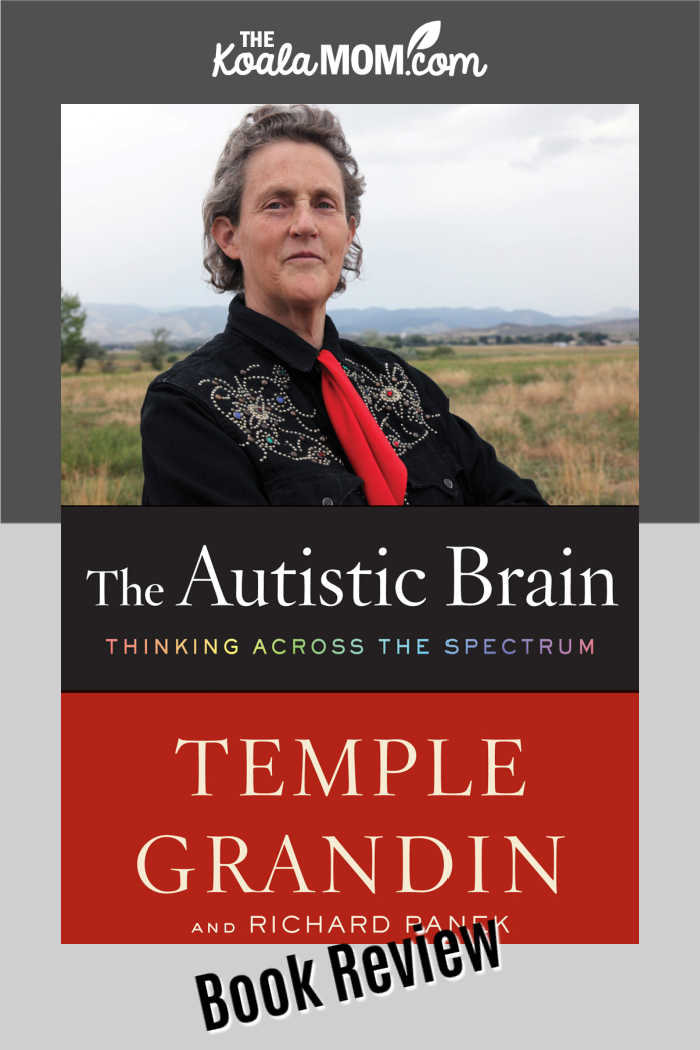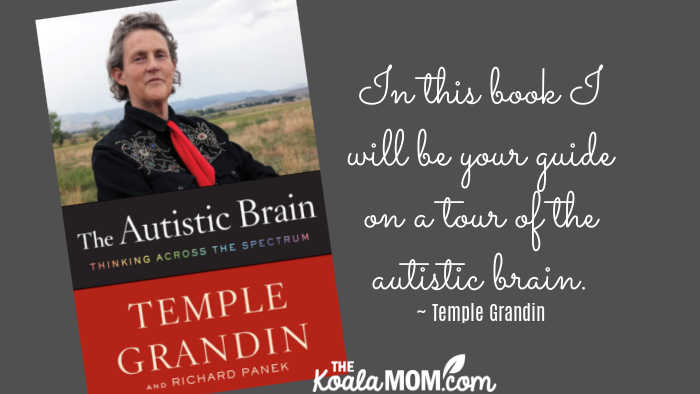Every once in a while, as I’m chasing my kids through the library or checking out dozens of books for them, I grab a book for myself. Usually it’s a book I’ve put on hold because a friend mentioned it, or a book that’s sitting bold and obvious and convenient on a display stand as I hurry past. Recently, the book that caught my eye was The Autistic Brain: Thinking Across the Spectrum by Temple Grandin.
April is Autism Acceptance Month, which is a great time to stop and learn more about the thousands of people around the world whose brains work differently than what’s considered “normal.” I realized that while I’ve heard this word for years, I don’t really know much about autism. Temple Grandin is a world-famous professor, author and speaker with autism. The Autistic Brain is a fascinating look at her story, current research on autism, what life is like for those with autism, and more.

I read this book for free thanks to my library; all opinions expressed remain my own. This post contains affiliate links; as an Amazon associate, I earn from qualifying purchases.
The Autistic Brain: Thinking Across the Spectrum overview
In this book I will be your guide on a tour of the autistic brain. ~ Temple Grandin
In the first chapter, Temple Grandin provides readers with a historic overview of autism and her own story of growing up with autism. She talks about the first person to identify autism, how diagnosis of autism has changed over the years, how her mother helped her learn and grow, and how autism is not in the mind—it’s in the brain.
Temple then goes on to look at MRI data and scientific studies of autism and how it affects her brains. This chapter and several others are very scientific, as Temple goes over various studies and what they mean for people in the autism community. She has had numerous MRIs done on her own brain and finds what she’s learned there about herself and her brain fascinating. For example, she knows that her “cerebellum is 20 percent smaller than the norm. The cerebellum helps control motor coordination, so this abnormality probably explains why my sense of balance is lousy.”
Temple talks about what these scientific studies have taught us, what they can’t teach us, and what could be done better to understand the differences between autistic brains and non-autistic brains. She says, “Autistic brains aren’t broken. My own brain isn’t broken. My circuits aren’t ripped apart. They just didn’t grow properly.” The MRIs of her own brain have helped her to understand herself better by knowing what’s unique about her brain and how that affects other areas of her life, such as balance.
From brain imaging, Temple moves to DNA. Is autism genetic? Again, she looks at numerous scientific studies that have probed this area and tries to answer the old “nature vs. nurture” question in relation to autism. This is an area where further study is needed, but Temple is hopeful that someday, genetics and brain imaging will help to create a better diagnosis of autism than purely observing behaviors.
She then goes into the behaviors that cause a person to get a diagnosis of autism. Many people with autism experience sensory struggles; Temple talks about her own dislike of certain noises. She asks, “What if you’re receiving the same sensory information as everyone else, but your brain is interpreting it differently? Then your experience of the world around you will be radically difference from everyone else’s, maybe even painfully so. In that case, you would literally be living in an alternate reality—an alternate sensory reality.”
We’re all individuals. We all have a range of skills, habits, preferences, limitations. What would a totally normal brain even be like? A brain that is average in every way, that has the average number of neural connections, the average size of amygdalae and cerebellum, the average length of corpus callosum? It would probably be pretty boring.
Of course, for many of us, autism is a label. We likely have some stereotypes we associate with this word (likely connected to famous figures or certain movie personifications). Temple invites readers to look past those labels, showing how the label may or may not be helpful. She talks about the limitations of the current methods of diagnosis autism, problems within the medical community, and the fact that “autism is not a one-size-fits-all diagnosis.”
Most of us see “autism” as a weakness or disability. Temple challenges readers to look at the strengths of those with autism, rather than the areas in which they lack. She’s honest throughout the book about her own struggles and weaknesses (she has troubles with balances, deals with a lot of anxiety, can’t do algebra) but also talks about her gifts and strengths (she has fantastic long-term memory, she can draw very detailed diagrams) and how those have helped her in her chosen career. What if, instead of focusing on the things that people with autism can’t do, we focus on the things they can do—and do very well? Again, she dives into some scientific studies here to illustrate different ways of looking at this.
Even after I learned that I’m autistic, I didn’t’ think about whether autism affected the way I saw the world. When I started designing livestock facilities in the 1970s, I couldn’t understand why other designers didn’t see obvious mistakes—mistakes I could see at a glance. I thought these people were stupid. Of course, I understand now that we were just looking at the world through very different sets of eyes—or should I saw, through very different kinds of brains.
In the final chapter, Temple puts together everything she’s discussed so far to advocate for kids today who are diagnosed with autism. She shares how numerous people with autism have had great success in various careers that allow them to use their strengths. She says, “I can play to my strengths… I took what nature gave me, and I nurtured the heck out of it.”
Temple has met many parents who can’t seem to see past their child’s autism diagnosis, who worry about that child’s future “with a disability.” While she doesn’t distinguish between “high-functioning” and “low-functioning” autism, she’s clearly speaking to “Aspies” such as herself who can develop their strengths to positively contribute to the world. She talks again about her own experience of growing up with autism, and what helped her succeed, and what may have helped her more. She gives practical tips to parents to help them nurture their child’s strengths, rather than trying to get them to learn something they’ll never be able to learn (like algebra, for Temple).
For me, autism is secondary. My primary identity is as an expert on livestock—a professor, a scientist, a consultant.
I love Temple’s view of a world in which diverse strengths and abilities are celebrated. As a mom of five kids, I’ve seen that each of my kids has their own strengths, weaknesses, personalities, and abilities. They all bring something interesting and unique to our family—and the same is true of the wider world. Kids with autism (or any other diagnosis) shouldn’t be shunted to the side, either in the classroom or in the workplace. Why? Because our world needs them and their unique gifts.
Okay, let’s say the autistic child has gotten an education that identified and developed his or her strengths. And let’s say that child has grown up to enter a marketplace that appreciates his or particular skill set. That’s great for that person. But you know what? It’s also great for society. Not only can you have different types of thinkers doing what they do best, but you can them doing what they do best alongside other types of thinkers who are doing what they do best.
My Thoughts on The Autistic Brain
Read it. Find it on Amazon or your library and read it now. Temple is honest, funny, experienced, and knowledgeable on the topic. While some chapters were slightly heavy reading thanks to all the scientific data, The Autistic Brain is an enlightening and hopeful look at how some people’s brains work. Whether you know someone who has autism or not (and you probably do), Temple Grandin will help you better understand what autism means and how, by welcoming those who see our world in a different way, we can all grow and build a better world together.
More about autism:
- Signs of Autism in Children: a helpful guide for parents
- Is Homeschooling Right for Children With Autism?
- Why Your Town Needs an Inclusive Playground
More about Temple Grandin
Temple Grandin is a professor of animal science at Colorado State University and the author of numerous best-selling books, including Visual Thinking: The Hidden Gifts of People Who Think in Pictures, Patterns, and Abstractions and Navigating Autism: 9 Mindsets For Helping Kids on the Spectrum.
She has a successful career consulting on livestock handling equipment design and animal welfare. Today, half the cattle in the US are handled in facilities she designed. She has been featured on numerous TV shows and her life story has been made into an award-winning movie by HBO. For more about Temple Grandin and autism, drop by her website.


No Responses Yet